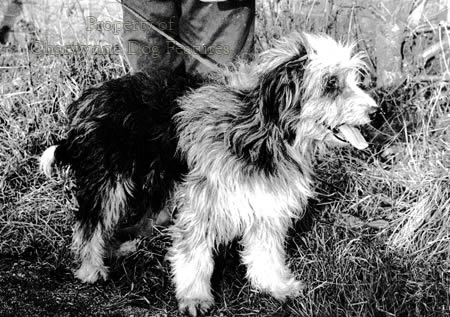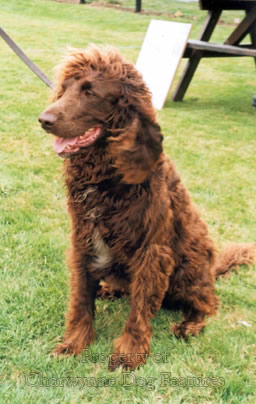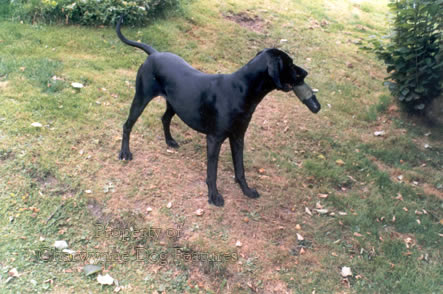862 BREEDING DOGS THAT WORK
BREEDING DOGS THAT WORK
by David Hancock
 In April 2013, Ch Littlethorn Colt at Tobermoray became the first Border Collie in over 18 years to obtain full champion status, for both his sheep herding and showing abilities. That is worthy of praise but it indicates that for all that time no Border Collie, the show version of our principal working sheepdog, gained such dual recognition; that is worrying. I can understand why the judge of Border Collies at a championship show in 2012 reported: “The shepherd needs a dog that is very athletic, has tight feet, well sloped pasterns, correct shoulders and powerful hindquarters to drive the dog through a long day’s work. Glamorous coats, perfect markings, straight pasterns and 10 to 12 pointy feet are all useless, even debilitating…I firmly believe we are breeding a show dog not a Border Collie.”
In April 2013, Ch Littlethorn Colt at Tobermoray became the first Border Collie in over 18 years to obtain full champion status, for both his sheep herding and showing abilities. That is worthy of praise but it indicates that for all that time no Border Collie, the show version of our principal working sheepdog, gained such dual recognition; that is worrying. I can understand why the judge of Border Collies at a championship show in 2012 reported: “The shepherd needs a dog that is very athletic, has tight feet, well sloped pasterns, correct shoulders and powerful hindquarters to drive the dog through a long day’s work. Glamorous coats, perfect markings, straight pasterns and 10 to 12 pointy feet are all useless, even debilitating…I firmly believe we are breeding a show dog not a Border Collie.”
A very enthusiastic young Danish dog-breeder asked me a couple of decades ago how the planning of purebred dog breeding was conducted in this country. We were both employed in livestock breeding and were aware of how science has long been and is ever increasingly contributing to that activity. I am afraid that my description of our dog breeding systems, apart from that conducted by one or two enlightened individuals and the Guide Dogs for the Blind Association, was full of regrets. By that I mean: little interest in the science of dog breeding from most breed societies, even less interest from the Kennel Club, at that time, and, seemingly, the lack of even one really determined individual to change the situation and prevailing attitudes. Compared to livestock breeders, far too many dog breeders are, in scientific breeding capability, ignorant, ill-informed and misguided. Oh, how tired I am of hearing experienced dog breeders use expressions like "Breed like to like, it's safer" or "The pedigree goes in at the mouth" or "Now that he's a champion, I'm going to use him on my bitch".
Pedigree Limitations
I had to tell my keen young Danish colleague that: we still only put numbers, names and coat colours on our pedigrees even in this advanced computer age; we still don't merit grade our dogs at shows, so that we never know relatively how good even the winners are; no one is appointed in each breed to act as a breeding adviser despite the existence of breed councils and there is no national scheme in dog breeding in the UK on the lines of the scientifically planned systems used in cattle and some other farm animals. If the Kennel Club exists for the improvement of dogs, as they themselves and perhaps alone claim, what have they been doing whilst their opposite numbers in farm animals have been forging ahead with enterprise and vision?
These words will no doubt bring a response that we've managed to get along without scientists so far, why do we need them now? I asked a livestock breeder who is also a pedigree dog breeder to comment on such a predictably negative response. Her reply was: "In livestock breeding science is wanted and welcomed, in dog breeding no one wants to know." What a commentary on attitudes five years before the next millennium! My own response is on these lines: Selection is still the main element in dog breeding but with a closed gene pool in every registered breed, with so many inheritable conditions manifesting themselves, how can we progress without the help of scientists? We judge the phenotype (i.e. what we see) but we should breed on the genotype (i.e. its genetic make up).
Looking recently at the five-generation pedigree of a new champion Bullmastiff and noting that it had 58 different ancestors out of a possible 62, brought to my notice very starkly just how small the part that scientific knowledge plays in such an activity. A livestock breeder can take advantage of: the internationally acclaimed BLUP (Best Linear Unbiased Prediction) technique, EBV's (Estimated Breeding Values) -- an estimated measure of the animal's genetic merit, BPA's Standards of Excellence for the pig, the grading up procedure and Sire Ranking Lists. In the show ring, farm animals are still judged to a scale of points related directly to the wording of the breed description or standard. A well-known dog breeder recently asked me what I meant by the expression "on the tail male side"! Where do we go from here?
Better-planned Breeding
If the Kennel Club declined to register a dog unless the breeder was a member of a breed society for that breed and insisted on each breed council appointing an official geneticist to advise on breeding programmes, then a start could be made. Geneticists are not renowned for their skill as breeders, but as professionally qualified advisers they could contribute so much, especially as the science of DNA-testing advances. I understand that DNA analysis is already contributing to the better-planned breeding of Bernese Mountain Dogs in Switzerland.
The time-honoured KC response to pleas for national schemes for the improvement of dog breeding has been to say that it's a matter for individual breeders and breed councils. But the German Kennel Club has instructed judges not to reward dogs with harmful exaggerations. The latter were considered to range from size of eyes, length of hair, shortness of muzzles and the quest for giant and dwarf dogs. Dr. Hellmuth Wachtel had a point when he wrote in the August the 25th edition of 'Dog World': "Basically, neither breeders nor judges nor other dog specialists were to blame; it is inherent in human nature to compete in surpassing an existing achievement. In dogs, that means that typical traits tend to be replaced by the more typical. So long hair grew longer until down to the ground, small eyes crept into the skull, short muzzles disappeared altogether". Who is going to address this problem? Vets, breed clubs alone and unaided, animal rights activists? But hasn't the KC set itself up as the ultimate authority in the UK for all matters affecting the pure-bred dog?
In The Daily Telegraph of August the 28th, 1996, it was reported that an 80 year old breeder of champions, a judge for over 50 years, resigned, saying: "For many, winning is all that matters...Breeders use talcum powder and other cosmetics to make the animals look better...Some pluck whiskers with tweezers to conceal the fact that the colour has been changed...Now they breed genetic inventions that don't normally exist and give them a fancy name." The report referred to a breeder of guinea pigs but its content supports Dr Wachtel's statement and dog fanciers will see some relevance in them. But if we acknowledge the strange whim in humans for selfish indulgence at the expense of living creatures, surely we can act in time to protect subject animals?
Dogmap and the Genome
In the absence of any moral leadership from our own Kennel Club, the responsibility for breeding out defects and harmful exaggerations is increasingly passing over to the scientist. The Animal Health Trust, for example, started gene-mapping in 1990 and participates in Dogmap, a worldwide effort to map the canine genome. Already the Department of Clinical Veterinary Medicine at Cambridge University, working with the Institute of Ophthalmology in London, has identified the gene responsible for PRA in Irish Setters. Potential carriers of the defect can now be omitted from breeding programmes. Work continues on locating the gene behind deafness in Dalmatians, a gene linked to the absence of coloured patches on the ears. Such work, and success, emphasises the pressing need for every breed council to appoint a geneticist to advise the breed.
This advisory role needs to be just that; it is vital that breeders remain in charge of breeding decisions. For example, hip dysplasia is a genetically transmitted disease that can only be reduced in incidence through rigorous genetic selection. It would be unwise however to cull on the basis of one flaw in an otherwise excellent dog. In a breed with plenty of really outstanding dogs, the ruthless culling of dogs with defective genes makes sense. But in breeds struggling to produce quality in volume, we should look at the merit of a dog excellent in other ways and aim to reduce the likelihood of inherited defects, through wise matings. Any dog with an inherited eye disease, epilepsy, a savage disposition or bad hips should definitely not be bred from but other defects must be balanced with the overall quality of the dog in question.
It is simply appalling to hear of a breeder continuing to breed from her stock knowing that she had primary glaucoma there. It is sad to hear breeders quoting pedigrees in their plans rather than the dogs themselves. It is depressing to hear breeders talking of using a certain stud dog because he has just been made a champion, or has recently been imported, or is just down the road or because there are lots of champions in his pedigree. It is foolish for dog breeders to stress one anatomical feature ahead of all others. Breeding for 'great bone' tells you at once that there is a surfeit of it between the ears of that particular breeder. Foxhound breeders learned the hard way a century ago that heavy club-like legs are actually less capable of endurance than the lighter ones. The forearm of the dog corresponds with the ankle in man; how many of us want heavy ankles? Why breed for something the dog doesn't need? Why breed dogs to a size their own ancestors never needed?
What does the DOG Need?
There is evidence that height at withers and body weight are quite highly inherited and tend to be related. Data in the breed of GSD showing that sixty-day weight in the breed is around 45% heritable and therefore weights at other ages would be connected, while the genes influencing weight will also tend to influence height. In a breed desiring to increase height, as in some LPD breeds, using some of the tallest animals in the breed could quickly raise heights in that breed. At the same time, not surprisingly, body weight would tend to increase too, whether desired or not. But increased size would bring with it a more rapid growth rate and possibly an increased rate of hip dysplasia. It would probably increase susceptibility of the long bones to diseases like panosteosis and it might lead also to reduced hind angulation. Straight stifles are almost a feature in some of our bigger heavier breeds. What truly is the value of seeking great size in a breed for its own sake and not for a distinct purpose benefiting the breed?
If we continue to breed for features a dog does not need we will not only do a disservice to dog but provide a great deal of ammunition to the ever-vocal anti-dog lobby. If we breed from the pedigree alone we will never retain type, character and the breed or kennel signature. If we do not breed for temperament we will be ignoring the key commercial fact that most purebred dogs become pets. If we breed for heads, bone, coat or excessive angulation in the hind-legs then we will get what we deserve: degeneration in the less valued areas. But if we do not embrace the advice of geneticists, introduce scientifically-designed breeding programmes and take every advantage of scientific progress then we might as well wear Victorian dress, for we will merely be perpetuating dated concepts. The requirement for planned breeding is now greater than ever. The capability of science to aid us is now greater than ever. We must not fail our dogs!